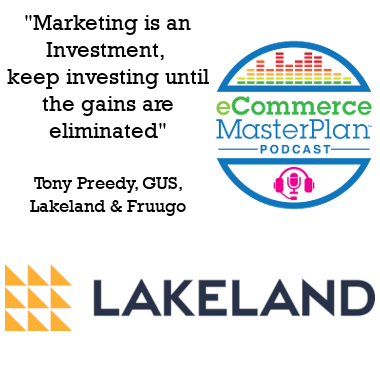Tony Preedy shares top marketing advice from his 25+yrs experience inc Littlewoods and Lakeland (episode 218)
Tony Preedy has been a marketing professional in the Home Shopping sector since 1991. Yes, today’s guest has over 25 years experience of getting the British (and overseas) public to spend money from the comfort of their own homes.
Including working for brands such as Lakeland, Otto, Littlewoods and more.
I’m really excited to have someone which such great experience of the eCommerce world (even before it existed!) on the show today to share a little of his years of experience with us.
Subscribe on your Favourite Podcast App
How Tony Got Started

Tony’ first job after University was working for GUS Home Shopping—which was part of GUS PLC.
Starting in the early ’90’s in the marketing department, Tony says his first project on the job was to create direct mailings. The common issues of customer segmentation, ROI and lifetime value were the same issues that Tony was dealing with on paper in those early days.
The company’s website came online in the very late ’90’s and they quickly added eCommerce. While the changes were dramatic, it wasn’t GUS’ first rodeo—Tony remembers working with people who had been in the home shopping sector before telephones were widely used and most people ordered by mail.
Luckily, the print catalogues format converted fairly seamlessly to online catalogues and digital marketing and communications came naturally after that.
Listen to learn about the role technology has played in the evolution of the home shopping sector.
Attribution in the Digital Age
Attribution of marketing spend, including understanding ROI is extremely challenging in the modern, online world. Tony says that before eCommerce it wasn’t difficult for his team to quantify customer response rate to 2 decimal place because everybody quoted a response code.
That metric was built in to the experience. So while multiple channels can be a powerful thing, that also means it’s more difficult to quantify what’s effective and what’s not.
Direct Mail
While direct mail may be unfashionable, good quality direct marketing inarguably generates a return on investment. When businesses reframe marketing as an investment rather than a cost, their relationship with the tools becomes more rational and companies can think about continuing to invest until the marginal gains run out rather than base spending—and judgement on a marketing budget. And as Tony points out—with the cost of a click rapidly approaching the cost of a stamp, it’s a good time to rethink the best way to contact customers.
Generating Sales from a Group of Customers
In an effort to reframe marketing altogether, Tony suggests that rather than thinking of marketing as a way to sell products, it can be helpful to think of it as a way to generate sales from a group of customers. This mindset allows businesses to take customer management on as a task and begin to more efficiently segment them. By taking a set of customers who are broadly alike, businesses can examine them more closely and ask questions like:
“What can I do to this group of people over a period of time to generate value for my business?”
Understanding the behaviour of customers over time influences your customer acquisition strategy as a whole. Tony also points out that it’s important to recognize that you often will have to sell to a customer more than once in order to cover the cost of acquiring the customer in the first place.
While this layered strategy is exciting, Tony also admits it is complex. Understanding which combination of actions yield a particular result can be dizzying. The secret to success is ultimately finding a system that yields statistics robust enough to be useful.
Google “Statistical Significance” if you want to learn more about Tony’s tip.
Segmentation
Segmentation starts with the customer—not the marketing method. According to Tony, channel is the least useful way to segment. Instead, when it comes to segmenting, he suggests focusing on the following:
- Tenure
- Frequency
- Value
Adapting to a Multichannel World
Shopping sectors are distance sellers, but Tony said his work at Lakeland, which had brick and mortar stores as well, contributed to his understanding of selling at the customer level.
While there are a lot of interesting marketing techniques that can be used in store level marketing, it’s also the most difficult to track customers. Trying to influence physical behavior using marketing can be done, but Tony says attribution remains difficult.
Setting Boundaries for Attribution
In order to capture some attribution, more and more retailers are assigning a geographic boundary around their retail locations inside of which they can attribute sales—whether they come from a physical purchase or an online one. The argument is that even seeing a physical retail location can influence behavior.
In a way, allowing retail locations to become marketing tools might ultimately save them. With physical footfall declining, understanding how to attribute and assign marketing dollars can be difficult.
Tony says that looking at the bigger picture is where the future of a holistic management is trending. Assigning rent money to the marketing budget for instance would be one way of justifying the benefits of a physical location.
What About Marketplaces?
There is no doubt about it—Marketplaces are convenient for customers. Today people are shopping primarily through search engines (Google, Bing and the like) or they are shopping on a preferred marketplace (eBay or Amazon).
Like department stores, marketplaces provide a service for consumers that are convenient and efficient with everything in one tidy place. Tony says that today it would be hard to grow an eCommerce business without participating in marketplaces.
Marketplace Tips:
- Marketplaces are a great place to discover new opportunities.
- Test sales—see what works for affecting sales in the controlled marketplace environment.
- Rediscover old techniques. Reconnect with the essentials like great copywriting. Getting back to the basics about why you were excited about a product in the first place.
eCommerce Book Top Tip
- Scientific Advertising by Claude Hopkins
eCommerce Traffic Top Tip
- Get good copy.
Copywriting is an underused and undervalued discipline within the eCommerce business. Crafting your product benefits into short succinct, powerfully related bullet points will make a huge difference.
Tool Top Tip
- Slack for instant messaging
- Collaboration tools like Jira to work on projects across the globe.
Growth Top Tip
- Underpromise and overdeliver.
Interview Links
Related episodes
Find all our interviews with £1m+ businesses here
Without the sponsors the podcast wouldn’t be possible – please do check them out:
This episode is brought to you by SendPro Online from Pitney Bowes.
SendPro Online makes it easy to save time and money–no matter what you send or ship–and you’ll always get the best rates and never overpay!
With SendPro, you can compare shipping rates between carriers, plus save 5 cents a letter and up to 40 percent off USPS Priority Mail shipping.
As a listener you can get a FREE 30-day trial and a FREE 10 pound scale, but only when you visit pb.com/masterplan

This episode is brought to you by the world’s first Pay as you Grow ecommerce platform – Shopit. Supporting online sellers of every size, Shopit gives EVERY customer EVERY feature they need to run an eCommerce business from day one – irrespective of their turnover. You can grow your empire with multiple web sites, full inventory management and more – all from one central login. What’s more, you ONLY pay for usage, so you can focus your budgets on your growth marketing. Plus there’s a lifetime low 1.6% payment gateway rate for everyone – Shopit really do support growing businesses.Sign up for your free trial now at shopitcommerce.com/masterplan




